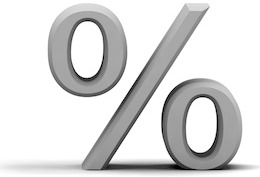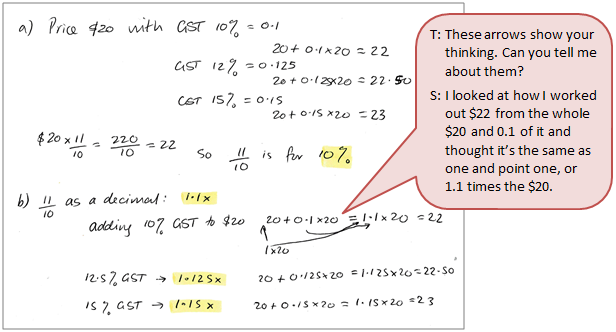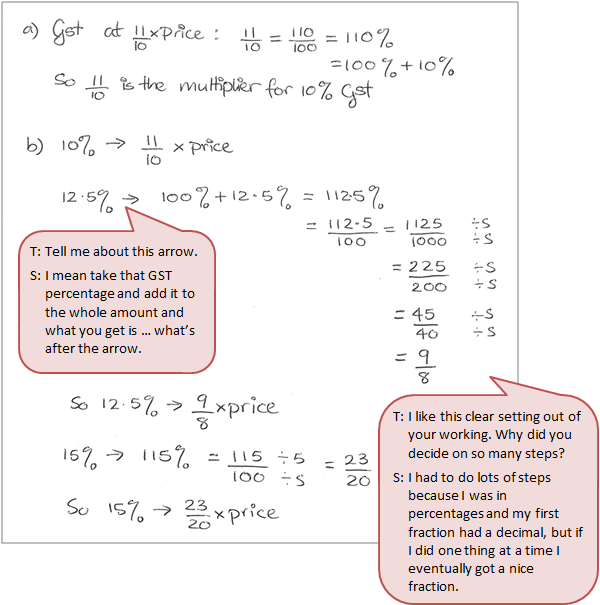The purpose of this activity is to engage students in expressing a percentage as a fraction and to be able to apply this as a multiplier.
This activity assumes the students have experience in the following areas:
- Convert between fractions, decimals, and percentages.
- Calculate with fractions, decimals, and percentages.
- Finding simple percentages of amounts.
The problem is sufficiently open ended to allow the students freedom of choice in their approach. It may be scaffolded with guidance that leads to a solution, and/or the students might be given the opportunity to solve the problem independently.
The example responses at the end of the resource give an indication of the kind of response to expect from students who approach the problem in particular ways.

Task: An old maths worksheet had a 'quick calculation trick' for working out the GST to add to the price of a product. The quick calculation said to multiply the GST exclusive price by 11/10.
- Was this quick calculation for when GST was, 10%, 12.5% or 15%?
- What would the fractions be for quick calculations for each GST value; 10%, 12.5% or 15%?
The following prompts illustrate how this activity can be structured around the phases of the Mathematics Investigation Cycle.
Make sense
Introduce the problem. Allow students time to read it and discuss in pairs or small groups.
- Do I understand all the words, or should I ask for help? (GST may not be a familiar term)
- Where else in my life/the world can I see this happen? (Students may need to see examples of GST in everyday life.)
- What mathematics do I need to solve this problem? (Students should recognise that the problem involves converting a percentage or decimal to a fraction. The fractions are greater than one so they are improper, i.e., numerator is greater than the denominator.)
- What might a solution look like? (Fractions will be used to calculate GST.)
Plan approach
Discuss ideas about how to solve the problem. Emphasise that, in the planning phase, you want students to say how they would solve the problem, not to actually solve it.
- What are the maths skills I need to work this out? (Convert between percentages and decimals and percentages.)
- Is there likely to be a pattern or generalisation? How do you know?
- How could I represent this problem using numbers, equations, pictures, graphs, tables, or materials? (Bar models are useful diagrams to solve percentage change problems.)
- What strategies can I use to get started?
- Could I make the numbers simpler to start, until I see a pattern? (What would the fraction be for GST of 50%? 25%? 20%)
- What tools (digital or physical) could help my investigation? (Calculators are essential.)
Take action
Allow students time to work through their strategy and find a solution to the problem.
- Have I shown my workings in a step-by-step way?
- Can I see some relationships between the percentages and decimals and fractions? How can I describe the relationships?
- What is the best way to record my working so I can see relationships?
- Have I got enough examples of different GST percentages to find a relationship?
- What mathematics is proving the most helpful? (Simplifying fractions using common factors is important to the task.)
Convince yourself and others
Allow students time to check their answers and then either have them pair share with other groups or ask for volunteers to share their solution with the class.
- What is the solution? Do I have fraction operators for the three different GST percentages?
- Have I generalised an algorithm for finding the fraction operator for any GST percentage?
- Can others see how I worked my fractions out?
- What connections can I see to other situations, why would this be? (The idea will apply to any percentage change situation.)
- Is there some mathematics that I need to learn or practise?
- Which representations and ideas would convince others that my findings answer the investigation question?
Examples of work
Work sample 1
The student expresses a GST inclusive price as a product of the exclusive price and a decimal.
Click on the image to enlarge it. Click again to close.
Work sample 2
The student expresses a GST inclusive price as a product of the exclusive price and an improper fraction.

